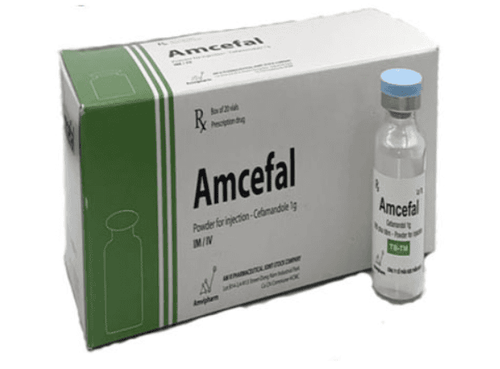This is an automatically translated article.
Invanz 1g is indicated for the treatment of moderate to severe infections caused by microorganisms susceptible to Ertapenem. The following article provides you with information about the uses, dosage and precautions when using Invanz 1g.
1. What are the effects of Invanz 1g?
Invanz 1g is a synthetic 1-B methyl-carbapenem, parenteral, long-acting, and structurally beta-lactam, such as penicillins and cephalosporins, active against anaerobic and aerobic bacteria. , gram negative and gram positive.
Invanz is prepared as a sterile lyophilized powder for intravenous infusion or intramuscular injection. Each vial contains lg of Ertapenem free radical acid. Each vial of Invanz also contains the following excipients: 175mg sodium bicarbonate and sodium hydroxide to adjust the pH to 7.5.
2. Indications and contraindications to the drug Invanz
2.1. Indications For Use Invanz Invanz is indicated for the treatment of moderate to severe infections caused by organisms susceptible to Ertapenem, in initial empiric therapy before the causative organism is identified in the following infections:
Complicated intra-abdominal infections. Complicated skin and skin tissue infections, including diabetic foot and lower extremity infections. Community-acquired pneumonia. Complicated urinary tract infections, pyelonephritis Acute pelvic infection, post-partum endometritis, septic abortion, post-operative gynecological infections. Sepsis . Invanz 1g is indicated for the prevention of local infections in adults during elective colorectal surgery. 2.2. Contraindications Invanz Allergy, hypersensitivity to Ertapenem or components of Invanz and antibiotics of the same group, patients have had anaphylactic reactions to beta-lactams. Because of the use of lidocaine HCI solvent for solution for intramuscular injection, Invanz 1g intramuscular injection is contraindicated in patients with known hypersensitivity to amide-type local anesthetics and in patients with severe shock or heart block.
3. How to use and dose Invanz
3.1. Dosage The usual dose of Invanz in patients 13 years of age and older is 1 g once daily.
The usual dose of Invanz in pediatric patients 3 months to 12 years of age is 15 mg/kg twice daily (not to exceed 1 g/day).
Prophylaxis of local infections in adults following elective colorectal surgery: the recommended dose is 1g intravenously, as a single dose 1 hour before surgery.
Patients with renal failure: Invanz 1g can be used to treat bacterial infections in adults with kidney failure. If the creatinine clearance is >30ml/min, no dose adjustment is required, if the creatinine clearance is <30ml/min, the dose is 500mg/day. Hemodialysis patients: If a daily dose of ertapenem is administered within 6 hours of dialysis, an additional 150 mg dose should be administered after dialysis is complete. No additional dose is required if ertapenem is administered more than 6 hours before hemodialysis.
Patients with hepatic impairment: No dose adjustment of Invanz 1g is required.
3.2. How to use Invanz can be used intravenously or intramuscularly. If the intravenous line is used, the infusion time should be more than 30 minutes.
The usual duration of treatment with Invanz is 3-14 days, but varies depending on the location and severity of the infection, the causative organism, and the patient's clinical response. If clinically indicated, when patients see clinical improvement, they can be switched to oral antibiotics.
4. Some notes when using Invanz
Serious and even fatal hypersensitivity reactions have been reported in patients receiving beta-lactam antibiotics. This reaction is more common in people with a history of hypersensitivity, allergies to many types of allergens. Some patients with a history of hypersensitivity to penicillin have also had severe hypersensitivity reactions to other beta-lactams. Therefore, before administering Invanz 1g, the patient should be thoroughly questioned about previous hypersensitivity reactions to penicillins, cephalosporins, beta-lactams and other allergens. In case the patient experiences an allergic reaction to Invanz 1g, the drug must be stopped immediately and given prompt emergency treatment.
Convulsions and other central nervous system side effects have been reported during the use of Invanz. According to a clinical study in adult patients treated with Invanz 1g once daily, seizures, whether drug related or not, occurred in 0.5% of patients during treatment and 14 days of follow-up. This side effect occurs most commonly in patients with CNS disorders (brain damage or history of seizures) or compromised kidney function. Strict adherence to the treatment regimen is recommended, especially in patients with risk factors for seizures.
Co-administration of valproic acid or divalproex sodium with ertapenem is not recommended. Antibiotics other than carbapenems can be used to treat infections in patients who are well controlled with valproic acid or divalproex sodium. Where it is necessary to use Invanz 1g, another anticonvulsant therapy may be considered.
Like other antibiotics, prolonged use of Invanz 1g will increase the growth of bacteria strains that are not sensitive to this antibiotic. The patient's response to treatment should be continuously assessed. If superinfection occurs during therapy, the appropriate treatment regimen should be adjusted.
Mild to life-threatening pseudomembranous colitis has been reported with most antibiotics including ertapenem. Therefore, this complication should be considered when the patient has diarrhea during treatment with Invanz.
Pregnant women: There are no adequate studies on the safety of using Ertapenem in pregnant women. Invanz 1g should be used during pregnancy only if the potential benefit outweighs the potential risk to the mother and fetus.
Lactating women: Ertapenem is excreted in breast milk. Use caution when administering Invanz 1g to lactating women.
5. Undesirable effects when using Invanz
According to clinical studies, adverse events with Invanz are mild to moderate in approximately 20% of patients receiving Ertapenem. Only about 1.3% of patients had to discontinue Invanz due to a drug-related adverse reaction.
Immune system: anaphylaxis, allergies. Psychiatric disorders: mental status changes (including agitation, aggression, delirium, disorientation, mental status changes) Nervous system disorders: headache, dizziness, somnolence, insomnia, convulsions, confusion, decreased consciousness, dyskinesia, gait abnormalities, hallucinations, myoclonus, tremor. Cardiovascular disorders: hypotension, extravasation, venous complications at the injection site, phlebitis , thrombophlebitis. Digestive disorders: diarrhea, nausea, vomiting, oral candidiasis, constipation, dry mouth, dyspepsia, loss of appetite. Skin and subcutaneous tissue disorders: erythema, pruritus, drug rash with eosinophilia and systemic symptoms. Musculoskeletal and connective tissue disorders: muscle weakness
6. Drug interactions
Probenecid: A competitive drug that inhibits the active tubular elimination of Ertapenem, which may increase the half-life and concentration of Ertapenem in the body. However, no dose adjustment of ertapenem is required when co-administered with probenecid. Valproic acid: Concomitant administration of Invanz will decrease its concentration, thereby increasing the risk of seizures.
Please dial HOTLINE for more information or register for an appointment HERE. Download MyVinmec app to make appointments faster and to manage your bookings easily.













